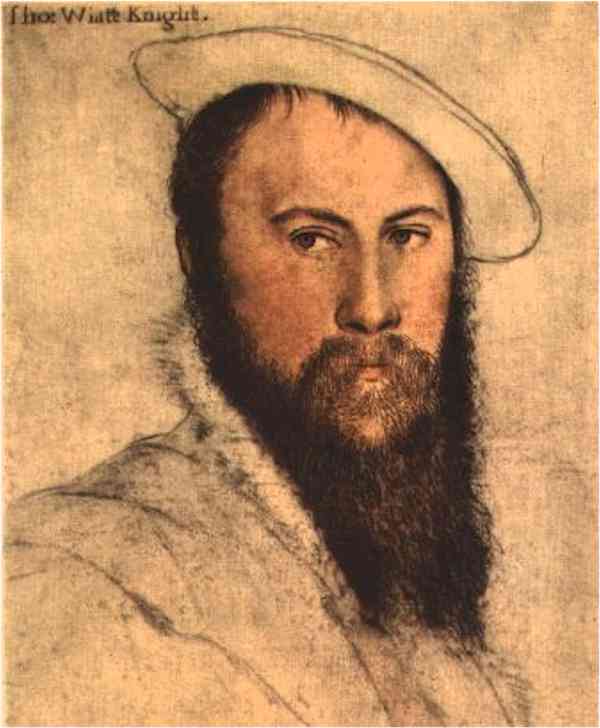|
 








|
Chapter Three English Literature in the
Renaissance
I. The English Poetry
1. Sir Thomas Wyatt (1503-42) and
Henry Howard, Earl of Surrey (1517?-1530)
 The flowering of English literature in the Renaissance started with a
sonnet. The sonnet developed in Italy of the 12th or 13th century but it had
reached its top in the 14th under
Francesco Petrarch, who
gave it the distinctive name and form. Traditionally, such sonnets as
Petrarch’s dealt with the theme of idealized love. From Petrarch, poets
would receive a great deal of conventions.
The flowering of English literature in the Renaissance started with a
sonnet. The sonnet developed in Italy of the 12th or 13th century but it had
reached its top in the 14th under
Francesco Petrarch, who
gave it the distinctive name and form. Traditionally, such sonnets as
Petrarch’s dealt with the theme of idealized love. From Petrarch, poets
would receive a great deal of conventions.
In the court of Henry VIII, a group of poets arose.
They would make significant contributions to the development of a literature
in English. These major “courtly poets” were Sir Thomas Wyatt and Henry
Howard, Earl of Surrey. With their translations of Petrarch’s work, Wyatt
and Surrey introduced the sonnet form into English.
In addition to translating Petrarch, both Wyatt and Surrey
wrote their own sonnets in English, thus establishing a poetic form and a
poetic tradition. Later many writers followed their suit.
Although the sonnet’s rules of order and arrangement might seem
limiting, the sonnet was a challenging "proving ground" for poets. It was a
test for them to write a good sonnet before they can try other forms of
literary works. It required a certain discipline that prepared them for more
creative, original works. In perfecting their own writing and technique,
they also well used English as a language for poetic efforts.
Following the tradition of Petrach, some poets even created a
sonnet sequence. A number of poems are connected with each other and deal
with a single subject. Sidney’s Astrophel and Stella,
Lady Mary Wroth’s
From Pamphilia to Amphilanthus, Shakespeare’s sonnets, and Spenser’s
Amoretti are examples of sonnet sequences.
Sir Thomas Wyatt can be known as the father of modern English
poetry for English poetry beginning with his translations from Petrarch.
Wyatt and his followers “exercised” the native languages in
two ways: they translated from classical models like Petrarch; they
experimented with many lyric measures in order to bring back the
flexibility, which was a little lost after Chaucer. In the following
example, this restoration of flexibility and vitality of English language is
manifested:
The Lover for Shamefastness Hideth
His Desire Within His Faithful heart.
HE long love that in my thought I harbour,
And in mine heart doth keep his residence,
Into my face presseth with bold pretence,
And therein campeth displaying his banner.
She that me learneth to love and to suffer,
And wills that my trust, and lust's negligence
Be reined by reason, shame, and reverence,
With his hardiness takes displeasure.
Wherewith love to the heart’s forest he fleeth,
Leaving his enterprise with pain and cry,
And there him hideth, and not appeareth.
What may I do, when my master feareth,
But in the field with him to live and die?
For good is the life, ending faithfully.
(Translated from Petrarch, Son 109)
Since Chaucer’s day, English had gone through many changes in
meaning and grammar. By the sixteenth century, writers had to work out their
own stylistics and metrics. Changes had also influenced how words were
pronounced or accented
These early poets were more like craftsmen not artists in a
sense. They didn’t write some new themes, and they used an old subject
matter so as to create a fluid style. They borrowed, imitated and translated
from Italian and French poets, and they borrowed from one another and
imitated each other as well. They kept their poetry in manuscript form and
relied on each other, and they didn’t show the poems to the public for
encouragement and criticism.
Wyatt’s poetic contributions are a bit uneven. He often seems
unsure of where the stress or accent should fall in a line; he often cannot
sustain an idea through the entire design of the poem, which is critical in
the sonnet, and his spellings are inconsistent, which makes the line’s
stress often unclear.
|
![]()
![]()